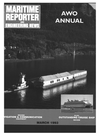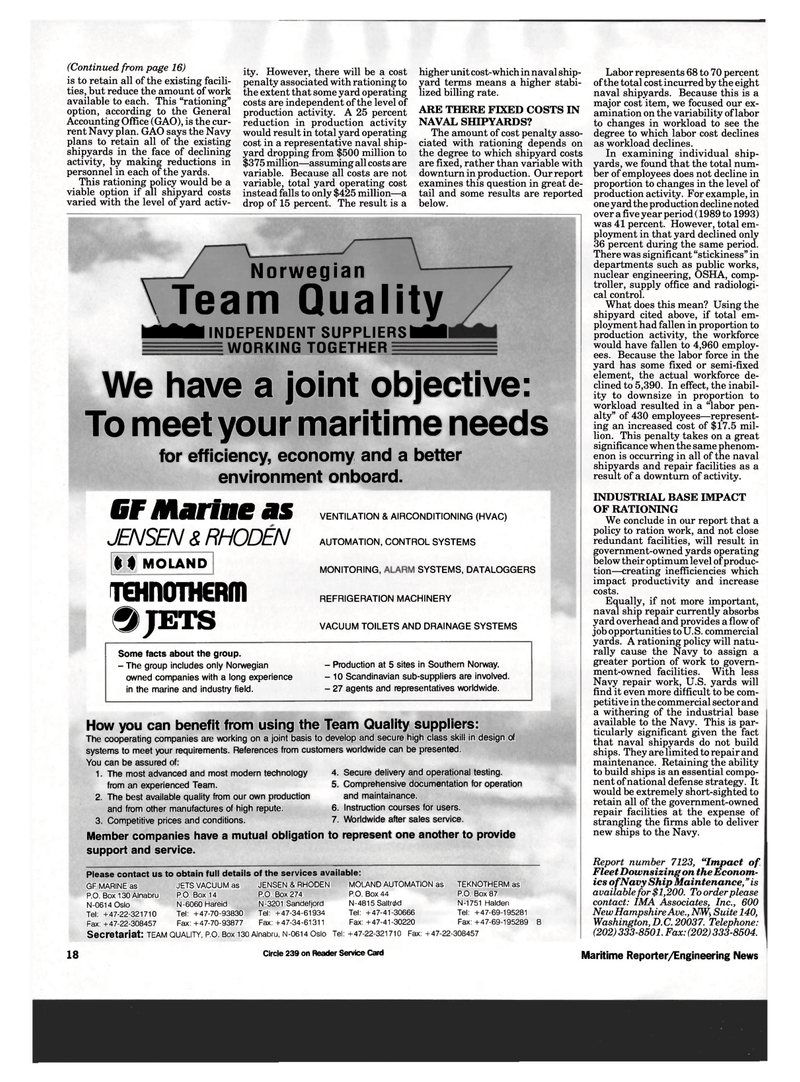
Page 16: of Maritime Reporter Magazine (March 1993)
Read this page in Pdf, Flash or Html5 edition of March 1993 Maritime Reporter Magazine
(Continued from page 16) is to retain all of the existing facili- ties, but reduce the amount of work available to each. This "rationing" option, according to the General
Accounting Office (GAO), is the cur- rent Navy plan. GAO says the Navy plans to retain all of the existing shipyards in the face of declining activity, by making reductions in personnel in each of the yards.
This rationing policy would be a viable option if all shipyard costs varied with the level of yard activ- $ $ MOLAND ity. However, there will be a cost penalty associated with rationing to the extent that some yard operating costs are independent of the level of production activity. A 25 percent reduction in production activity would result in total yard operating cost in a representative naval ship- yard dropping from $500 million to $375 million—assuming all costs are variable. Because all costs are not variable, total yard operating cost instead falls to only $425 million—a drop of 15 percent. The result is a
MONITORING, higher unit cost-which in naval ship- yard terms means a higher stabi- lized billing rate.
ARE THERE FIXED COSTS IN
NAVAL SHIPYARDS?
The amount of cost penalty asso- ciated with rationing depends on the degree to which shipyard costs are fixed, rather than variable with downturn in production. Our report examines this question in great de- tail and some results are reported below.
SYSTEMS, DATALOGGERS
Labor represents 68 to 70 percent of the total cost incurred by the eight naval shipyards. Because this is a major cost item, we focused our ex- amination on the variability of labor to changes in workload to see the degree to which labor cost declines as workload declines.
In examining individual ship- yards, we found that the total num- ber of employees does not decline in proportion to changes in the level of production activity. For example, in one yard the production decline noted over a five year period (1989 to 1993) was 41 percent. However, total em- ployment in that yard declined only 36 percent during the same period.
There was significant "stickiness" in departments such as public works, nuclear engineering, OSHA, comp- troller, supply office and radiologi- cal control.
What does this mean? Using the shipyard cited above, if total em- ployment had fallen in proportion to production activity, the workforce would have fallen to 4,960 employ- ees. Because the labor force in the yard has some fixed or semi-fixed element, the actual workforce de- clined to 5,390. In effect, the inabil- ity to downsize in proportion to workload resulted in a "labor pen- alty" of 430 employees—represent- ing an increased cost of $17.5 mil- lion. This penalty takes on a great significance when the same phenom- enon is occurring in all of the naval shipyards and repair facilities as a result of a downturn of activity.
INDUSTRIAL BASE IMPACT
OF RATIONING
We conclude in our report that a policy to ration work, and not close redundant facilities, will result in government-owned yards operating below their optimum level of produc- tion—creating inefficiencies which impact productivity and increase costs.
Equally, if not more important, naval ship repair currently absorbs yard overhead and provides a flow of job opportunities to U.S. commercial yards. A rationing policy will natu- rally cause the Navy to assign a greater portion of work to govern- ment-owned facilities. With less
Navy repair work, U.S. yards will find it even more difficult to be com- petitive in the commercial sector and a withering of the industrial base available to the Navy. This is par- ticularly significant given the fact that naval shipyards do not build ships. They are limited to repair and maintenance. Retaining the ability to build ships is an essential compo- nent of national defense strategy. It would be extremely short-sighted to retain all of the government-owned repair facilities at the expense of strangling the firms able to deliver new ships to the Navy.
Report number 7123, "Impact of
Fleet Downsizing on the Econom- ics of Navy Ship Maintenance," is available for $1,200. To order please contact: IMA Associates, Inc., 600
New Hampshire Ave., NW, Suite 140,
Washington, D.C. 20037. Telephone: (202) 333-8501. Fax: (202) 333-8504.
TEHnOTHERfT)
SJETS
REFRIGERATION MACHINERY
VACUUM TOILETS AND DRAINAGE SYSTEMS
Some facts about the group. - The group includes only Norwegian owned companies with a long experience in the marine and industry field. - Production at 5 sites in Southern Norway. - 10 Scandinavian sub-suppliers are involved. - 27 agents and representatives worldwide.
How you can benefit from using the Team Quality suppliers:
The cooperating companies are working on a joint basis to develop and secure high class skill in design of systems to meet your requirements. References from customers worldwide can be presented.
You can be assured of: 1. The most advanced and most modern technology from an experienced Team. 2. The best available quality from our own production and from other manufactures of high repute. 3. Competitive prices and conditions.
Member companies have a mutual obligation to represent one another to provide support and service. 4. Secure delivery and operational testing. 5. Comprehensive documentation for operation and maintainance. 6. Instruction courses for users. 7. Worldwide after sales service.
Please contact us to obtain full details of the services available:
GF MARINE as
P.O. Box 130 Alnabru
N-0614 Oslo
Tel: +47-22-321710
Fax: +47-22-308457
JETS VACUUM as
P.O. Box 14
N-6060 Hareid
Tel: +47-70-93830
Fax: +47-70-93877
JENSEN & RHODEN
P.O. Box 274
N-3201 Sandefjord
Tel: +47-34-61934
Fax: +47-34-61311
MOLAND AUTOMATION as
P.O. Box 44
N-4815 SalMd
Tel: +47-41-30666
Fax: +47-41-30220
TEKNOTHERM as
P.O. Box 87
N-1751 Halden
Tel: +47-69-195281
Fax: +47-69-195289 B
Secretariat: TEAM QUALITY, P.O. Box 130 Alnabru, N-0614 Oslo Tel: +47-22-321710 Fax: +47-22-308457 "A Norwegian
VTeam Quality
Mftftl INDEPENDENT SUPPLIERSMM WORKING TOGETHER
We have a joint objective:
To meet your maritime needs for efficiency, economy and a better environment onboard.
GF Marine as
JENSEN & RHODEN
VENTILATION & AIRCONDITIONING (HVAC)
AUTOMATION, CONTROL SYSTEMS 18 Circle 239 on Reader Service Card Maritime Reporter/Engineering News

 15
15

 17
17
